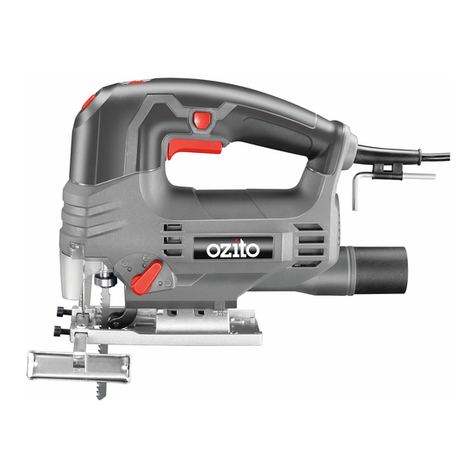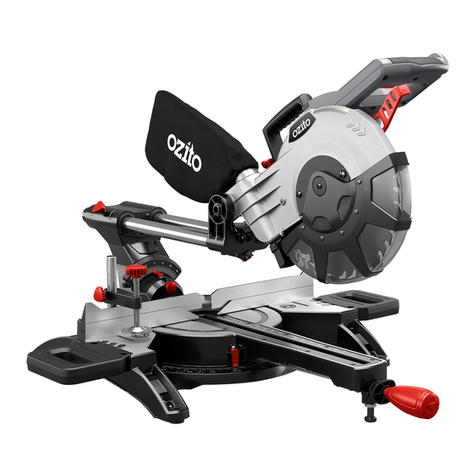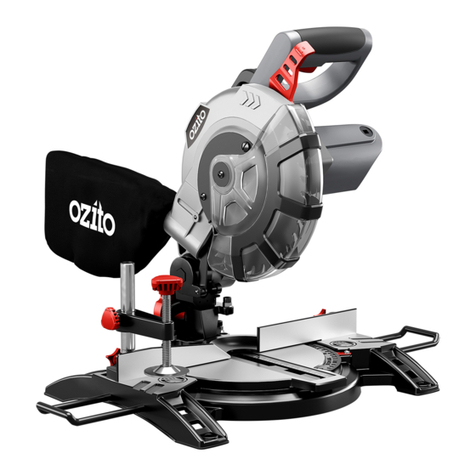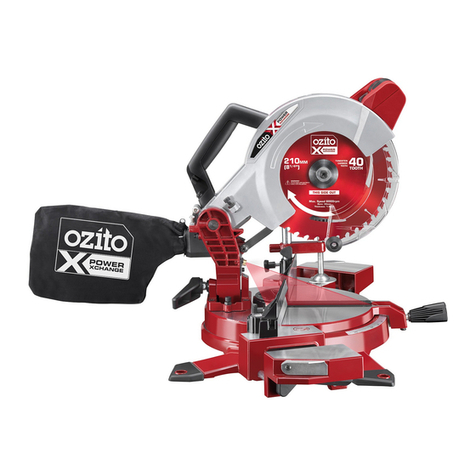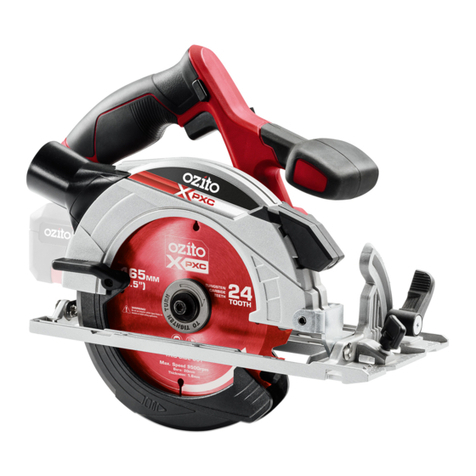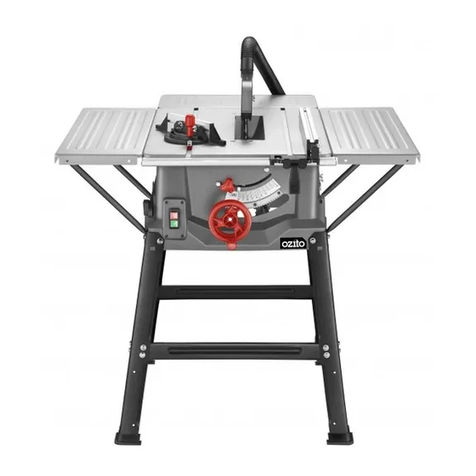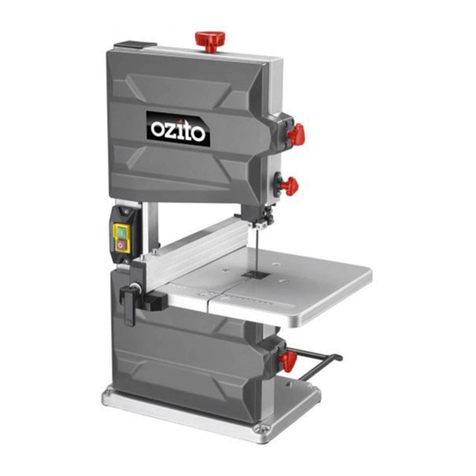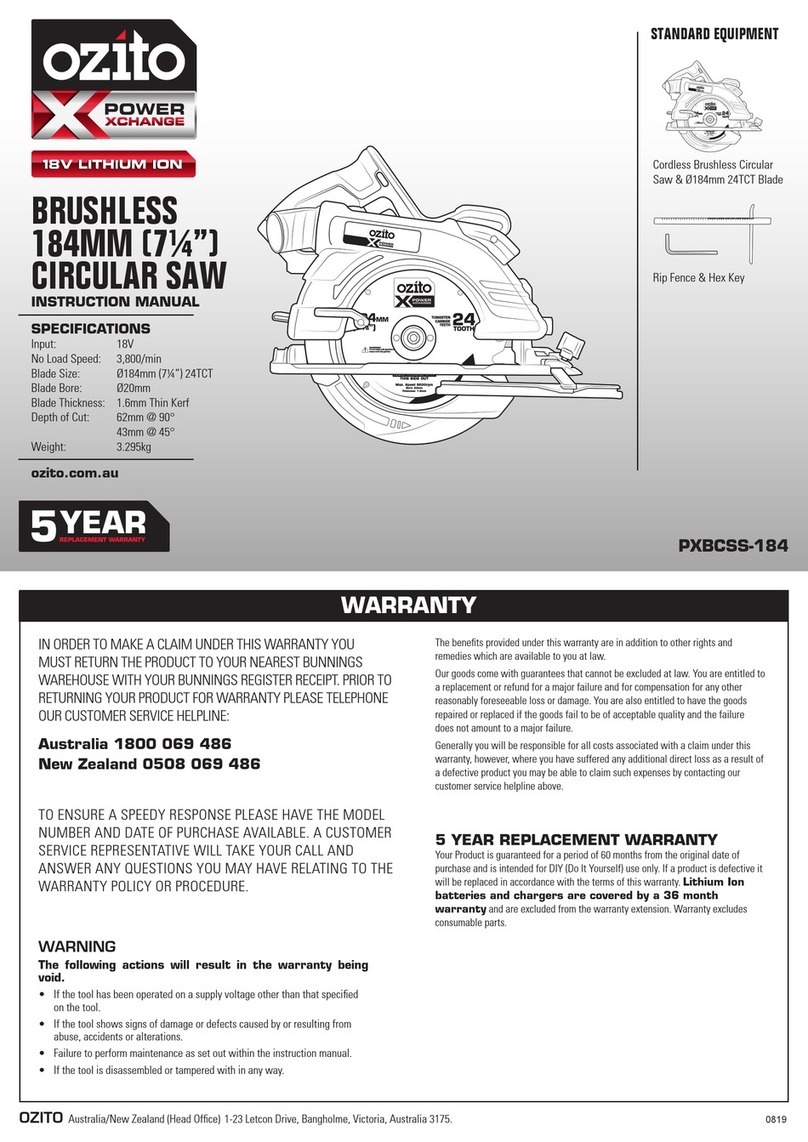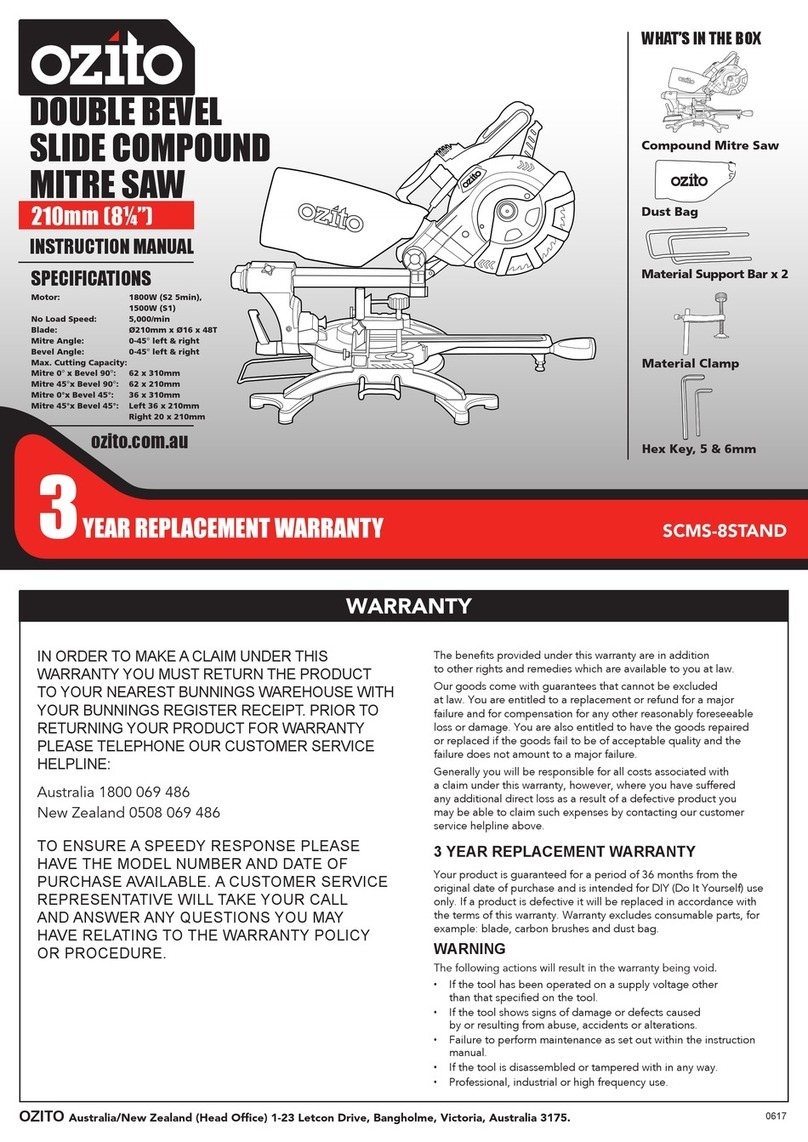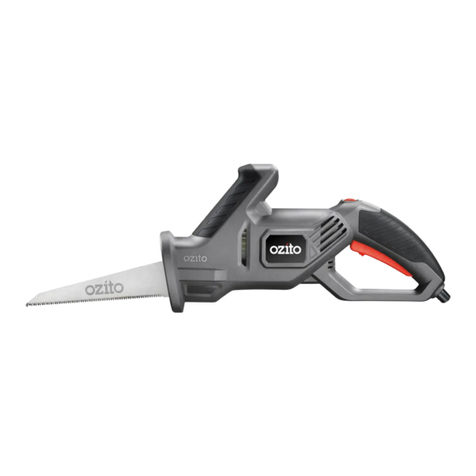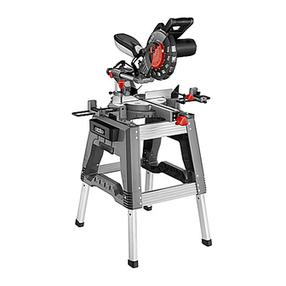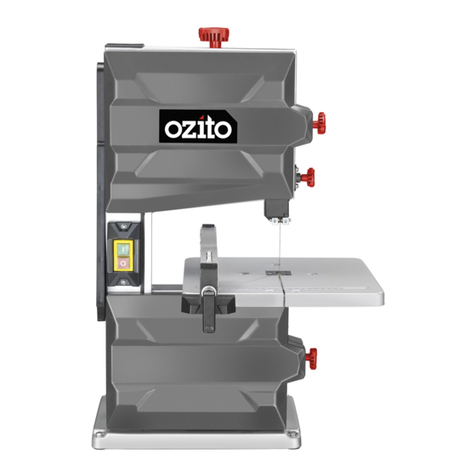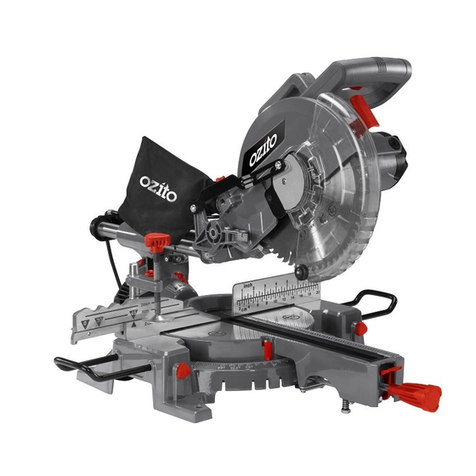
WARNING! The appliance is not to be used by persons (including children) with reduced physical,
sensory or mental capabilities, or lack of experience and knowledge, unless they have been given
supervision or instruction. Young children should be supervised to ensure that they do not play
with the appliance.
• Mitre saws are intended to cut wood or wood-like products, they cannot be used with abrasive cut-off
wheels for cutting ferrous materials such as bars, rods studs, etc. Abrasive dust causes moving parts such
as the lower guard to jam. Sparks from abrasive cutting will burn the lower guard, the kerf insert and other plastic
parts.
• Use clamps to support the workpiece whenever possible. If supporting the workpiece by hand, you must
always keep your hand at least 100mm from either side of the saw blade. Do not use this saw to cut pieces
that are too small to be securely clamped or held by hand. If your hand is placed too close to the saw blade,
there is an increased risk of injury from blade contact.
• The workpiece must be stationary and clamped or held against both the fence and the table. Do not feed the
workpiece into the blade or cut “freehand” in any way. Unrestrained or moving workpieces could be thrown at
high speeds, causing injury.
• Never cross your hand over the intended line of cutting either in front or behind the saw blade. Supporting
the workpiece “cross handed” i.e. holding the workpiece to the right of the saw blade with your left hand or vice
versa is very dangerous.
• Do not reach behind the fence with either hand closer than 100 mm from either side of the saw blade, to
remove wood scraps, or for any other reason while the blade is spinning. The proximity of the spinning saw
blade to your hand may not be obvious and you may be seriously injured.
• Inspect your workpiece before cutting. If the workpiece is bowed or warped, clamp it with the outside
bowed face toward the fence. Always make certain that there is no gap between the workpiece, fence
and table along the line of the cut. Bent or warped workpieces can twist or shift and may cause binding on the
spinning saw blade while cutting. There should be no nails or foreign objects in the workpiece.
• Do not use the saw until the table is clear of all tools, wood scraps, etc., except for the workpiece. Small
debris or loose pieces of wood or other objects that contact the revolving blade can be thrown with high speed.
• Cut only one workpiece at a time. Stacked multiple workpieces cannot be adequately clamped or braced and may
bind on the blade or shift during cutting.
• Ensure the mitre saw is mounted or placed on a level, firm wok surface before use. A level and firm work
surface reduces the risk of the mitre saw becoming unstable.
• Plan your work. Every time you change the bevel or mitre angle setting, make sure the adjustable fence is
set correctly to support the workpiece and will not interfere with the blade or the guarding system. Without
turning the tool “ON” and with no workpiece on the table, move the saw blade through a complete simulated cut to
assure there will be no interference or danger of cutting the fence.
• Provide adequate support such as table extensions, saw horse, etc. for a workpiece that is wider or longer
than the table top. Workpieces longer or wider than the mitre saw table can tip if not securely supported. If the
cut-off piece or workpiece tips, it can lift the lower guard or be thrown by the spinning blade.
• Do not use another person as a substitute for a table extension or as additional support. Unstable support for
the workpiece can cause the blade to bind or the workpiece to shift during the cutting operation pulling you and the
helper into the spinning blade.
• The cut-off piece must not be jammed or pressed by any means against the spinning saw blade. If confined,
i.e. using length stops, the cut-off piece could get wedged against the blade and thrown violently.
• Always use a clamp or fixture designed to properly support round material such as rods or tubing. Rods have
a tendency to roll while being cut, causing the blade to “bite” and pull the work with your hand into the table.
• Let the blade reach full speed before contacting the workpiece. This will reduce the risk of the workpiece being
thrown.
• If the workpiece or blade becomes jammed, turn the mitre saw off. Wait for all moving parts to stop and
disconnect the plug from the power source and/or remove the battery pack. Then work to free the jammed
material. Continued sawing with a jammed workpiece could cause loss of control or damage to the mitre saw.
• After finishing the cut, release the switch, hold the saw head down and wait for the blade to stop before
removing the cut-off piece. Reaching with your hand near the coasting blade is dangerous.
• Hold the handle firmly when making an incomplete cut or when releasing the switch before the saw head
is completely in the down position. The braking action of the saw may cause the saw head to be suddenly pulled
downward, causing a risk of injury.
• Always remove the plug from the mains socket before making any adjustments or maintenance, including changing
the blade.
• When operating the saw, use safety equipment including safety goggles or shield, ear protection, dust mask and
protective clothing including safety gloves. Keep hands away from moving parts.
• Ensure that there is adequate general or localised lighting. Never saw near combustible liquids or gases. Keep the
floor area around the machine level, well maintained and free of loose materials.
• Do not use the saw unless the guards are in place. Periodically check that all nuts, bolts and other fixings are
properly tightened.
• Never use a cracked or distorted saw blade. Do not use blades of High Speed Steel (HSS blades).
• If the table insert is damaged or worn, have it replaced by a power tool repairer.
• Do not store materials or equipment above a machine in such a way that they could fall into it.
• Always hold the saw on parts that are insulated. If you accidentally cut into hidden wiring or the saw’s own cable,
the metal parts of the saw will become “live”. Switch off at the mains and remove the plug immediately.
• Do not lock the movable guard in the open position and always ensure that it is working properly, freely rotating and
returning to fully cover the teeth of the blade. Ensure that the arm is properly secure when bevelling.
• Connect the saw to a dust collection device and ensure that it is operating properly. As the operator of the saw,
please make sure that you understand factors that influence exposure to dust, including the type of material to be
cut, the importance of local extraction and the proper adjustment of hoods/baffles/chutes of your dust extraction
system. We recommend that you always wear a dust mask when operating this saw.
• When cutting long pieces which extend well over the table width, ensure that the ends are adequately supported
at the same height as the saw table top. Supports should be positioned in such a way to ensure that the workpiece
does not fall to the ground once the cut has been made. A number of supports at regular intervals may be required if
the workpiece is extremely long.
• Do not force the tool, allow the blade to cut the workpiece. Failure to do so may overheat the blade, reducing the life
of the product. Push the saw through the workpiece. Do not pull the saw through the workpiece.
• Do not remove any cut-offs from the cutting area until the mitre saw head is in the full upright position, the blade
guard is fully enclosing the blade and the blade has come to a rest or complete stop. Never use your hands to
remove sawdust, chips or waste close by the blade.
• Do not slow or stop a blade with a piece of wood. Let the blade come to rest without assistance. If you are
interrupted when operating the saw, complete the process and switch off before looking up.
• Take additional care when trenching (slotting). Hold the handle firmly when making an incomplete cut or when
releasing the switch before the saw head is completely in the down position. The braking action of the saw may
cause the saw head to be suddenly pulled downward, causing a risk of injury.
• Note the direction of rotation of the motor and the blade. Use correctly sharpened saw blades and observe the
maximum speed marked on the blade. Only use saw blades with maximum speeds equal to or higher than the
maximum speed marked on the tool. Only use (diameter) 254 x (bore) 25.4 x (kerf) 3.0mm blades with this saw.
• This saw is only meant for cutting timber and plastics. Do not use the saw to cut metal or masonry. Do not use this
saw to cut firewood. When cutting plastics the heat generated by the saw blade tips may melt the plastic. Always do
a test cut on scrap material beforehand. Avoid cutting nails. Inspect the workpiece and remove all nails and other
foreign objects before operating the saw.
• Periodically wipe the laser lens gently with a dry soft cloth. Ensure the unit is switched off before doing so. Do not
stare directly into the laser. Always check the laser on a workpiece.
• The mitre saw can be safely carried by the carrying handle but only once it has been removed from the mains power
and secured in the locked down position. Saw blades shall be carried in a holder wherever possible.
MITRE SAW SAFETY WARNINGS
GENERAL POWER TOOL SAFETY WARNINGS
WARNING! Read all safety warnings and all instructions. Failure to follow the warnings and instructions
may result in electric shock, fire and/or serious injury. The term “power tool” in the warnings refers to your
mains-operated (corded) power tool or battery-operated (cordless) power tool.
1. Work area safety
a. Keep work area clean and well lit. Cluttered or dark areas invite accidents.
b. Do not operate power tools in explosive atmospheres, such as in the presence of flammable liquids, gases
or dust. Power tools create sparks which may ignite the dust or fumes.
c. Keep children and bystanders away while operating a power tool. Distractions can cause you to lose control.
2. Electrical safety
a. Power tool plugs must match the outlet. Never modify the plug in any way. Do not use any adapter plugs
with earthed (grounded) power tools. Unmodified plugs and matching outlets will reduce risk of electric shock.
b. Avoid body contact with earthed or grounded surfaces, such as pipes, radiators, ranges and refrigerators.
There is an increased risk of electric shock if your body is earthed or grounded.
c. Do not expose power tools to rain or wet conditions. Water entering a power tool will increase the risk of
electric shock.
d. Do not abuse the cord. Never use the cord for carrying, pulling or unplugging the power tool. Keep cord
away from heat, oil, sharp edges or moving parts. Damaged or entangled cords increase the risk of electric
shock.
e. When operating a power tool outdoors, use an extension cord suitable for outdoor use. Use of a cord
suitable for outdoor use reduces the risk of electric shock.
f. If operating a power tool in a damp location is unavoidable, use a residual current device (RCD) protected
supply. Use of an RCD reduces the risk of electric shock.
3. Personal safety
a. Stay alert, watch what you are doing and use common sense when operating a power tool. Do not use
a power tool while you are tired or under the influence of drugs, alcohol or medication. A moment of
inattention while operating power tools may result in serious personal injury.
b.Use personal protective equipment. Always wear eye protection. Protective equipment such as dust mask,
non-skid safety shoes, hard hat, or hearing protection used for appropriate conditions will reduce personal injuries.
c. Prevent unintentional starting. Ensure the switch is in the off-position before connecting to power source
and/or battery pack, picking up or carrying the tool. Carrying power tools with your finger on the switch or
energising power tools that have the switch on invites accidents.
d. Remove any adjusting key or wrench before turning the power tool on. A wrench or a key left attached to a
rotating part of the power tool may result in personal injury.
e. Do not overreach. Keep proper footing and balance at all times. This enables better control of the power tool
in unexpected situations.
f. Dress properly. Do not wear loose clothing or jewellery. Keep your hair, clothing and gloves away from
moving parts. Loose clothes, jewellery or long hair can be caught in moving parts.
g. If devices are provided for the connection of dust extraction and collection facilities, ensure these are
connected and properly used. Use of dust collection can reduce dust-related hazards.
h. Do not let familiarity gained from frequent use of tools allow you to become complacent and ignore tool
safety principles. A careless action can cause severe injury within a fraction of a second.
4. Power tool use and care
a. Do not force the power tool. Use the correct power tool for your application. The correct power tool will do
the job better and safer at the rate for which it was designed.
b. Do not use the power tool if the switch does not turn it on and off. Any power tool that cannot be controlled
with the switch is dangerous and must be repaired.
c. Disconnect the plug from the power source and/or the battery pack from the power tool before making
any adjustments, changing accessories, or storing power tools. Such preventive safety measures reduce the
risk of starting the power tool accidentally.
d. Store idle power tools out of the reach of children and do not allow persons unfamiliar with the power tool
or these instructions to operate the power tool. Power tools are dangerous in the hands of untrained users.
e. Maintain power tools. Check for misalignment or binding of moving parts, breakage of parts and any other
condition that may affect the power tool’s operation. If damaged, have the power tool repaired before use. Many
accidents are caused by poorly maintained power tools.
f. Keep cutting tools sharp and clean. Properly maintained cutting tools with sharp cutting edges are less likely to
bind and are easier to control.
g. Use the power tool, accessories and tool bits etc. in accordance with these instructions, taking into
account the working conditions and the work to be performed. Use of the power tool for operations different
from those intended could result in a hazardous situation.
h. Keep handles and grasping surfaces dry, clean and free from oil and grease. Slippery handles and grasping
surfaces do not allow for safe handling and control of the tool in unexpected situations.
5. Service
a. Have your power tool serviced by a qualified repair person using only identical replacement parts. This will
ensure that the safety of the power tool is maintained.
